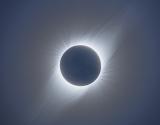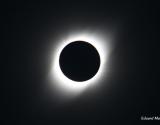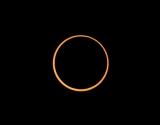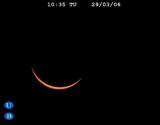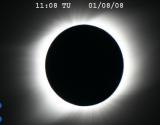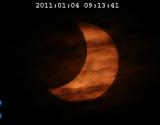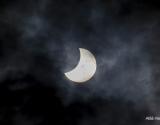Solar Eclipse
Partial solar eclipse (October 25th, 2022)
On Tuesday, October 25th, 2022, there will be a partial solar eclipse visible from northeastern Spain. In addition, the eclipse will be visible from most of Europe, northeast Africa and western Asia.
Total Solar Eclipse 02/07/2019
Next 2nd July a Total Solar Eclipse will happen. The beginning of the eclipse will be in eastern New Zealand in the Pacific Ocean and it will move to Chile and Argentina. The eclipse will be seen as partial from most of South America.
Annular Sun eclipse 2005
The next Monday 3rd of October,2005 it will take place a solar annular eclipse. This eclipse will be visible in a strip of the Península Ibérica and in the African continent. This eclipse will be "partial" in the rest of Europe and most of Africa and Asia.
Eclipsi total de Sol (1 d'agost de 2008)
Partial Solar eclipse (January 4, 2011)
Total Sun eclipse (March 20, 2015)
Preguntes freqüents
- What is an eclipse of the Sun?
- Which characterístics have the different types of eclipses?
- Why don't eclipses ocurr every new Moon?
- How to observe a solar eclipse?
- Where in the Earth can we observe a solar eclipse?
- Previous Eclipses
- When will the next eclipses occur?
- What is the Saros cycle?
 |
What is an eclipse of the Sun?
A solar eclipse occurs when the Moon passes between the Earth and Sun and the Moon's shadow crosses the Earth. From the Earth, the Moon and the Sun have almost the same diameter. Moreover, due to the distance variations betweem the Moon and the Earth, Moon can be seen from the Earth bigger or smaller than the Sun. This gives as a result the three types of eclipses: total, partial or annular.
Which characterístics have the different types of eclipses?
PARTIAL ECLIPSE
The Moon's orbit around the Earth is tilted 5 degrees to Earth's orbit around the Sun. A partial eclipse is when the Moon is not completely aligned with the Earth and the Moon. Part of the Earth is inside the shadow caused by the Moon, The Moon's shadow actually has two parts: Penumbra, that is the faint outer shadow, and the Umbra, the dark inner shadow. When only the Moon's penumbral shadow strikes Earth, we see a partial eclipse of the Sun from that region (see Fig, 1). All solar eclipses begin as partial as the Moon shadow is moving up to its maximum.
 |
| Figure 1: Basic geometry of the Sun, Moon and Eath during a partial eclipse of the Sun. |
ANNULAR ECLIPSE:
When the Moon is perfectly aligned between the Earth and the Sun, but the Moon is in the far side of its orbit, the Moon's umbral shadow is not long enough to reach Earth (see Fig, 2). This is called an annular solar eclipse. An observer located in the path of annularity will see an eclipse where a ring or "annulus" of bright sunlight surrounds the Moon at the maximum phase.
 |
| Figure 2: Basic geometry of the Sun, Moon and Earth during an annular eclipse of the Sun. |
TOTAL ECLIPSE:
Finally, when the Moon is on the near side of its orbit, the Moon appears larger than the Sun. If an eclipse occurs at that time it will be a total eclipse of the Sun (see Fig. 3). Theses eclipses are very interesting. Besides looking directly at the Sun, as the direct light of the Sun is blocked some other rare phenomena can be watched. The first effect is the so called Bailly's beads. As the narrow crescent of the Sun finally begins to disappear, tiny specks of light remain visible for a few seconds more. These points of light are spaced irregularly around the disappearing edge of the Sun, forming the appearance of a string of beads around the dark disk of the Moon. The beads are actually the last few rays of sunlight shining through valleys on the edge of the Moon. Baily's beads make their brief appearance up to 15 seconds before totality. When a single point of sunlight remains, a beautiful "diamond ring" effect is created against the outline of the Moon. This final sparkling instant signals the arrival of the moon's shadow. The last ray of sunlight vanishes and totality begins. Against the backdrop of the white corona and the black disk of the Moon, two colorful effects are usually seen. First is the light from the Sun's lower atmosphere, the chromosphere. For a few seconds both after the beginning and before the end of totality, this pinkish glow appears at the edge of the Moon. Also often visible are several solar prominences. These red cloudlike appendages arch above the surface, reach a maximum height of nearly one-third the diameter of the Sun itself. Ussually this effects are not seen due to the bright light of the Sun, unless an eclipse occurr. Nowadays, there are instruments designed to produce this effect of blocking the Solar disc and thus, permitting the observation of the different levels of the atmosphere of the Sun (the chromosphere and the corona).
 |
| Figure 3:Basic geometry of the Sun, Moon and Earth during a total eclipse of the Sun . |
Why don't eclipses ocurr every new Moon?
Eclipses only occur if the satellite of a planet is located within 0.5 degrees of the plane of the ecliptic, on a line that passes through the center of the Sun and Earth. The Moon travels along an orbit inclined by 5 degrees to the ecliptic plane, so there are only two opportunities each month -- when it passes through the plane of the ecliptic -- called the ascending and descending nodes. These two points connected to the barycenter of the Earth-Moon system (the point around which the objects orbit, in this case roughly Earth's center) define a 'line of nodes.' Eclipses of the Sun and Moon will occur if this line of nodes coincides with the line drawn between the center of Earth and the Sun. Again, the Moon also has to be within 0.5 degrees of one or the other of the nodes so that the disk of the Sun is partially or totally covered in a solar eclipse. A similar argument explains why lunar eclipses do not happen every full Moon at the node opposite the Sun from Earth. Decimos que la Luna se encuentra en fase de luna nueva cuando sólo recibe la luz del Sol por el lado opuesto a la Tierra, por lo tanto, en un eclipse de Sol siempre estaremos en fase de luna nueva. El motivo por el que no en todas las lunas nuevas hay un eclipse se debe a que la órbita de la Luna está ligeramente inclinada (5 grados y 6 minutos) respecto al plano Tierra-Sol. Por tanto la mayoría de las veces la luna nueva se sitúa en un plano diferente y es sólo cuando la luna nueva se produce en el plano Tierra-Sol, o muy cercano a éste, que se produce un eclipse de Sol.
How to observe a solar eclipse?
NEVER LOOK AT THE SUN DIRECTLY
Viewing of the Sun without suitable eye protection is EXTREMELY dangerous and can easily lead to total loss of eyesight. The retina does not have pain sensors, so you will not know that you are experiencing eye damage. Ensure that you have adequate eye protection (special eclipse viewing glasses, solar filters). More info here
 |
Where in the Earth can we observe a solar eclipse?
In contrast with lunar eclipse, that can be viewed from everywhere in the Earth while night time, solar eclipses are only seen through very specific areas. Thus, the eclipse will be total (or annular) over a narrow corridor of a few hundreds of kilometers wide and a few thousands of kilometers corresponding to the path of the Moon shadow over the Earth. In a wider corridor the eclipse will be seen as partial.
Previous Eclipses
Some eclipses in the past:
- The last Sun total, 08/21/2017 . Totality visible from the north of the Pacific, the United States, South Atlantic
- The last ring, 02/26/2017 . The passage of the eclipse crossed the southern tip of Chile and Argentina, spread across the Atlantic in Angola, the Democratic Republic of the Congo and Zambia. The eclipse only covered 99% of the solar disk.
- Retransmitted from Serviastro:
- Annular-total solar eclipse (November 3, 2013). Visible in the Pacific and the equatorial part of Africa. In Catalonia visible as partial, almost negligible, 0.6%.
- 4th January 2011 Retransmission of Serviastro from Barcelona (53.3%). Visible from all the Iberian Peninsula. In addition, the eclipse has been visible, always as partial, from Europe, the northern half of Africa, the Middle East and the western half of Asia.
- 1st August 2008 Serviastro Retransmission from China. Visibility began in Canada and ended in China, passing close to the North Pole, Siberia and Mongolia.
- 29th March 2006 Serviastro retransmission from Barcelona and from Egypt. The visibility crossed the African continent from the west to the east and from south to north. This event could be seen as partial from Catalonia.
- 3rd October 2005. Retransmisión Serviastro from Barcelona Bicopr / Quesa (Valencia), Formentera. The strip of annularity crossed the Iberian Peninsula from northwest to southeast. From Barcelona, the eclipse was observed as partial.
- Other totals visible from Catalonia:
- Eclipses visible as total and hybrid respectively from Spain, but as partial from Catalonia. August 30, 1905 and April 17, 1912.
- Total eclipse visible from Catalonia. July 8, 1842
- July 2, 2019. Total solar eclipse. Visible from the south Pacific, Chile and Argentina.
- December 26, 2019. Annular Eclipse of Sun. Visible from Saudi Arabia, India, Sumatra and Borneo.
When will the next eclipses occur?
Below are the next solar eclipses that stand out for some reason:
- June 21, 2020. Annular Eclipse of Sun. Visible from Central Africa, South Asia, China and the Pacific
- December 14, 2020. Total solar eclipse. Visible from the South Pacific, Chile, Argentina and the South Atlantic.
- June 10, 2021. Annular Eclipse of Sun. Visible from Northern Canada, Greenland, and Russia. Partial from Catalonia (2.3%)
- December 4, 2021. Total solar eclipse. Visible from Antarctica.
- October 25, 2022. Partial solar eclipse visible from Catalonia (3.5%)
- March 29, 2025. Partial solar eclipse visible from Catalonia (13.5%)
- August 12, 2026. Next total eclipse visible from Spain. It is observable in the southern zone of Catalonia. (Partial 99.8% in BCN)
- August 2, 2027. Total solar eclipse, visible from Catalonia as partial (81.7%)
- January 26, 2028. Next annular eclipse visible from Spain. It is observable in this phase in the extreme southwest of Catalonia (82.3%).
What is the Saros cycle?
The Saros cycle exists because it takes 18 years and 10 days for the entire orbit of the Moon to precess once around in its orbit plane so that the lunar nodes make one complete revolution along the orbit. This "Nordical" period equals nearly an integer number of lunar months (223 x 29.53 days = 6,585.19 days) during each Saros cycle. Because the true length of the Saros cycle is 6,585.32 days, you have to wait three Saros cycles in order for a solar eclipse to repeat at the same spot on Earth. Successive eclipses in the Saros cycle happen one-third of the way around the world from each other, and after three Saros cycles, the eclipse returns to nearly the same geographic location after 54 years and 33 days. Twelve different Grand Saros eclipse series are now occurring, with the one producing the eclipses of 1937, 1955, 1973, 1991 and 2009, each having a duration near the 7.5 minute limit.
